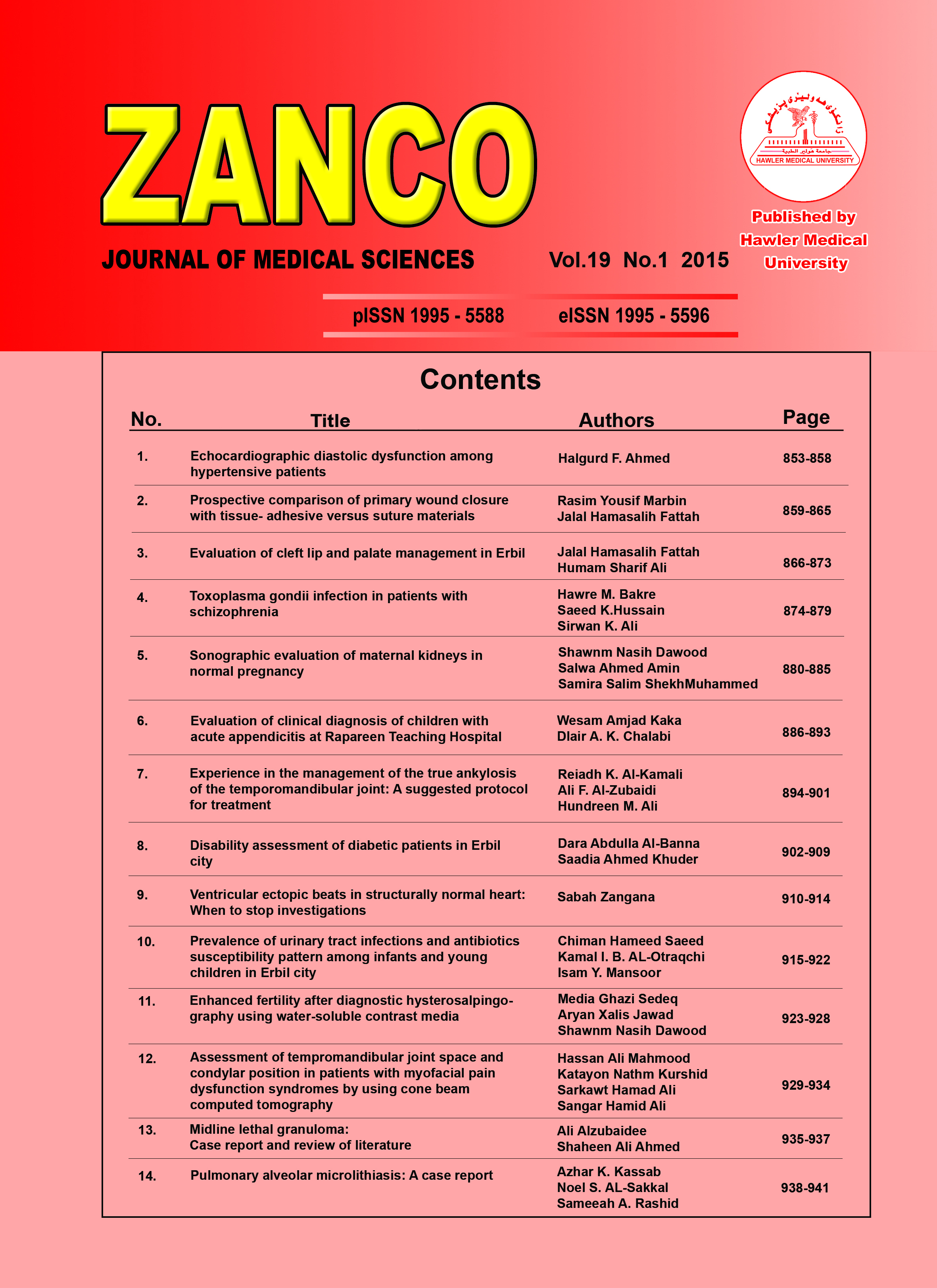Keywords:
Copyright and Licensing:
Copyright (c) 2015 Sabah Z. Zangana (Author)

This work is licensed under a Creative Commons Attribution-NonCommercial-ShareAlike 4.0 International License.
- Articles
- Submited: September 19, 2018
-
Published: April 1, 2015
Abstract
Background & Objectives: Ventricular ectopic beats (extra systoles, premature beats) are frequently found in healthy people. Ectopic beats in patients without apparent heart disease are more prominent at rest and disappear with exercise. Treatment is not necessary unless the patient is highly symptomatic. Methods: Patients having ventricular ectopic beats were assessed clinically, by ECG and by echocardiography. Those with normal structure hearts underwent exercise ECG and among those we selected 50 patients whose ectopics were suppressed by exercise then followed them for 5 years. The study started from 2000 to 2010. Results: During 5-year follow-up of the above mentioned patients, relevant complications such as dangerous ventricular arrhythmias, ischemic heart diseases or heart failure were not recorded. Conclusions: In patients having ventricular ectopic beats and structurally normal heart, the suppressibilty of the ectopic by exercise indicated their benign origin and may preclude further invasive investigations and even specific treatment.Metrics
Metrics Loading ...
References
- Mohamed H, Hamdan. Cardiac Arrhythmias. In:Andreoli and Carpenter’s Cecil essentials of medicine.8th ed. USA : Suanders Elsevier; 2012.P. 121- 2.
- William G S. Ventricular arrhythmias. In : Goldman;s Cecil Medicine. 24th ed. USA: Saunders Elsevier; 2012. P. 359-68.
- Jeffrey E O, Douglas P, Zipes. Specific Arrhythmias Diagnosis and Treatment. 7th ed. Braunwald’s heart disease. USA :Saunders Elsevier; 2005.P. 838-41.
- D. E. Newby, N .R. Grubb, A. Bradbury. Et el Cardiovascular disease. In: Davidson’s principles and practice of medicine.21st.ed. UK:Churchill Livingstone Elsevier 2012.p 566
- Marchlinski F. The Tachyarrhythmias.In:Harrison’s principles of internal medicine.17th ed.USA: McGraw Hill. 2008 p.1435
- Andre NG. Treating patients with ventricular ectopic beats. Heart 2006; 92: 1707–12.
- Jouven X, Zureik M, Desnos M. Long-term outcome in asymptomatic men with exercise-induced premature ventricular depolarizations. N Engl J Med 2000; 343: 826-33.
- Morshedi-Meibodi A, Evans JC, Levy D. Clinical correlates and prognostic significance of exercise-induced ventricular premature beats in the community: the Framingham Heart Study. Circulation 2004; 109: 2417-22.
- Lee V , Hemingway H, Harb R, Crake T, Lambiase P .The prognostic significance of premature ventricular complexes in adults without clinically apparent heart disease: a meta-analysis and systematic review. Heart; 98:1290-8.
- Abdalla IS, Prineas RJ, Neaton JD. Relation between ventricular premature complexes and sudden cardiac death in apparently healthy men. AM J Cardiol 1987; 60(13) 1036–42.
- Bikkina M, Larson MG, Levy D. Prognostic implications of asymptomatic ventricular arrhythmias: the Framingham Heart Study. Ann Intern Med 1992; 117 (12):990-6.
- Orth-Gomer K, Hogstedt C, L Bodin L, Soderholms TB. Frequency of extra systoles in healthy male employees. Br Heart J 1986; 55: 259-66.
- Kennedy HL, Whitlock JA, Sprague MK. Long-term follow-up of asymptomatic healthy subjects with frequent and complex ventricular ectopy. N Engl J Med 1985; 312:193-7.
- Alessandro Biffi, MD, Pelliccia A, MD , Verdile L. Am Coll Cardiol. Long-term clinical significance of frequent and complex ventricular tachyarrhythmias in trained athletes Am Coll Cardiol 2002; 40(3):446-52.
- Busby MJ, Shefrin EA, Fleg JL.Prevalence and long-term significance of exercise-induced frequent or repetitive ventricular ectopic beats in apparently healthy volunteers. J Am Coll Cardiol1989; 14: 1659–65.
- Mora S, Redberg RF, Cui Y .Ability of exercise testing to predict cardiovascular and all-cause death in asymptomatic women. JAMA. 2003; 290: 1600–7.
- Omar A R, Lee L C, Seow S C, Teo S G, Poh K K. Managing ventricular ectopics: are ventricular ectopic beats just an annoyance?. Singapore Med J 2011; 52 (10):707-14.
How to Cite
Zangana, S. Z. (2015). Ventricular ectopic beats in structurally normal heart: When to stop investigations. Zanco Journal of Medical Sciences (Zanco J Med Sci), 19(1), 910_914. https://doi.org/10.15218/zjms.2015.0011





